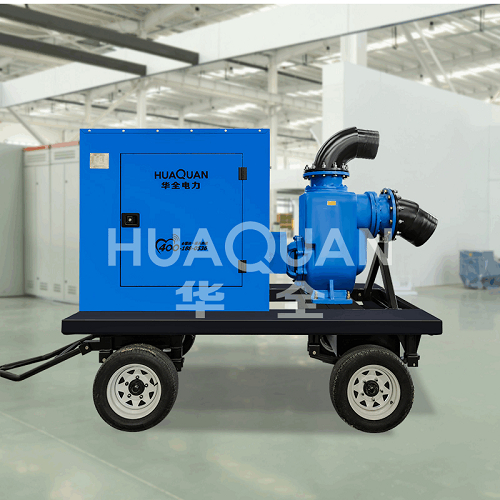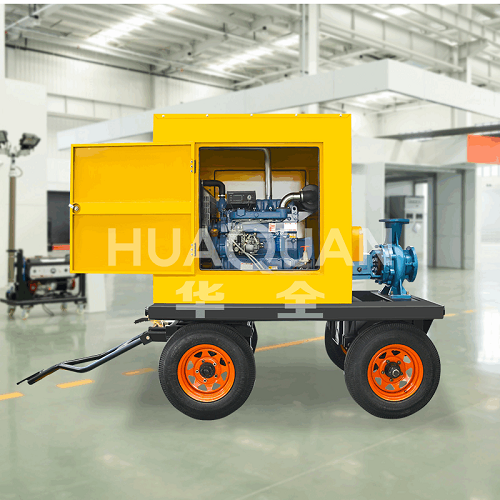Deep within mines, water inrush and seepage constantly threaten production safety, personnel, and equipment.
Mine dewatering diesel pumps, with their exceptional independent power performance, have become indispensable "mobile fortresses" and "emergency vanguards" in mine dewatering systems. They are particularly suitable for underground operations where power supply is unstable, environments are complex, and mobility is critical.
I. Core Advantages: How has diesel power become the backbone of mine dewatering?
1. No power outage worries, absolute power independence:
Free from the constraints of the power grid, diesel pumps can be immediately activated in the event of a sudden mine power outage or in remote, power-free areas (such as open-pit mines and newly constructed working faces), ensuring continuous dewatering operations and mitigating the risk of flooding.
In mine flood emergency response plans, diesel pumps feature prominent emergency rescue capabilities and are core emergency equipment.
2. Powerful, robust, and reliable:
Meeting the challenges of deep well dewatering and long-distance water transport (hundreds of meters to kilometers), diesel engines provide powerful torque to easily drive high-lift, high-flow pumps.
The rugged and durable design is specifically designed for the dusty, humid, and vibrating environments of mines, ensuring stable operation under harsh conditions.
3. Flexible and maneuverable, fast and efficient deployment:
Equipped with a heavy-duty tire chassis or skid-mounted base, it can be quickly towed and hoisted to various operating locations (excavation face, water tank, temporary sump).
The drainage location can be flexibly adjusted as the mining progresses, significantly improving response efficiency.
4. Continuous operation, ensuring long-term drainage:
The large-capacity fuel tank design (generally supporting continuous operation for over 8 hours) and a backup fuel tank ensure long-term, uninterrupted drainage.
The relatively long maintenance cycle reduces downtime for maintenance.
II. Key Selection Factor: Precisely Matching Mine Drainage Requirements
When purchasing a dedicated mining diesel pump, it is important to carefully consider the specific requirements:
1. Performance Parameters:
Flow rate (m³/h): Determined based on the maximum water spray volume and drainage time requirements. 20m standard mining models offer flow rates ranging from 3/h to 3000m³/h+. Lift (m): The pump must overcome the depth of the mine, pipeline losses, and water discharge height. Deep mines require high-lift models (up to 200m or more).
Suction Lift (m): A pump capacity of 6-8 meters is generally recommended for low-lying pits, and higher capacity can be achieved with specialized designs.
Particle Diameter (mm): Select the appropriate pump type (clean water pump, sewage pump, or slurry pump) based on the size of impurities (coal slag, rock debris) in the water.
2. Structure and Materials:
Pump Body Materials: High-chromium alloy cast iron, cast iron, stainless steel, etc., for wear and corrosion resistance.
Sealing System: Heavy-duty mechanical seals or packing seals, suitable for water containing impurities.
Frame and Base: Heavy-duty steel structure for vibration resistance and protection of core components.
Silencing and Protection: Optional mufflers and rain covers can reduce noise (especially in underground tunnels) and adapt to open-air environments.
3. Mobility and Control:
Mobility: Heavy-duty solid tire/pneumatic tire trailer, skid-mounted (requires lifting). Control System: Simple manual control, instrument monitoring panel, and even remote start/stop/monitoring (optional).
Self-priming Capacity: Whether it has a self-priming function and the self-priming time.
III. Key Application Scenarios: Protecting every "water defense line" in the mine.
Underground tunnel drainage: Water inrush from the working face, drainage of accumulated water at the tunneling head, and auxiliary drainage from the central water tank.
Open-pit mine water removal: Flood prevention during the rainy season, daily pit bottom water removal.
Emergency Rescue: Rapid response and drainage for sudden water flooding incidents.
Construction Drainage: Water inrush during construction of new vertical shafts, inclined shafts, and tunnels.
Temporary Drainage Points: Highly mobile, suitable for temporary water collection points formed during excavation.
IV. Guidelines for Safe and Efficient Use: Standardize operations to ensure human and machine safety.
1. Site and Environment:
Ventilation! Ventilation! Ventilation! When using underground, ensure excellent ventilation in the workspace and promptly exhaust fumes (including carbon monoxide). Avoid open-air or enclosed spaces.
The ground must be stable and level, and the equipment must be placed horizontally to prevent shifting and tipping during operation. Equip a fire extinguisher (explosion-proof certification is required for underground installations) and keep away from flammable and explosive materials.
2. Startup Operation:
Check the oil level (engine oil, diesel) and coolant level. If insufficient, add the specified oil immediately.
Check that the inlet and outlet pipes are tightly connected and leak-free, ensuring the inlet pipe is tightly sealed.
Rotate the pump shaft to confirm smooth rotation without binding.
Open the pump exhaust valve and prime the pump (this step is required for non-self-priming pumps).
Start the diesel engine according to regulations and heat it up at low speed for several minutes.
Observe the pressure and vacuum gauges as they gradually return to normal values, without any abnormal vibration or noise.
3. Operation Monitoring:
Closely monitor the diesel engine instruments (water temperature, oil pressure, speed), and pump pressure/flow.
Monitor the operating sound of the equipment. Immediately stop and inspect any abnormal vibration, noise, overheating, or smoke.
Regularly check pipes and joints for leaks.
4. Shutdown and Maintenance:
Stop the engine after the speed gradually decreases. Do not suddenly shut down the engine at high speed. During extended periods of non-use in cold environments, clean cooling water (not antifreeze) should be added to prevent cracking.
Perform regular maintenance: Strictly follow the manual instructions to replace engine oil, machine filter, diesel filter, and air filter (due to high dust levels in mines, air filter cleaning requires more frequent and intensive changes). Check and adjust belt tension and water pump packing/seals.
After extended periods of non-use, perform rust-proofing treatment and restart the equipment regularly.
Conclusion: A Solid Backing for Mine Drainage
Mine diesel pumps play an irreplaceable role in complex, ever-changing, safety-critical mine drainage systems. They offer self-sufficiency, high performance, flexible mobility, and sustainable reliability. By thoroughly understanding their performance characteristics, accurately selecting the right one for your needs, strictly adhering to safety operating procedures, and implementing scientific maintenance, choosing a professional mine drainage equipment supplier with customized solutions and full lifecycle services will help build a safer, more efficient, and more worry-free drainage system for your mines.
For more information, visit:
http://www.huaquandongli.com/



